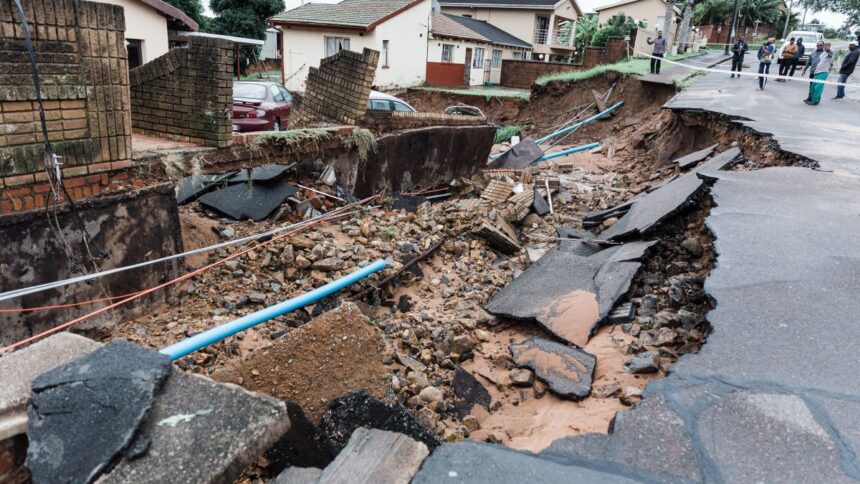Over 300 killed after flooding washed away roads, destroyed homes in South Africa

By David McKenzie, Larry Madowo, Mia Alberti and Angela Dewan, CNN
Heavy rains and flooding battered the eastern coast of South Africa on Wednesday, killing at least 306 people, damaging roads and destroying homes.
The tragedy marked “one of the darkest moments in the history” of the KwaZulu-Natal province, the regional government said in a tweet.
“We join the families in mourning the lives that we have lost as a result of the heavy rains,” the government wrote. “We wish to commend disaster management teams for the tireless work they have been doing to evacuate affected communities.”
The flooding hit KwaZulu-Natal, which includes the coastal city of Durban. Roads cracked and gave way to deep fissures, and a huge stack of shipping containers collapsed into muddy waters, news agency images show.
A bridge near Durban was swept away, leaving people stranded on either side.
KwaZulu-Natal has experienced extreme rainfall since Monday in what the provincial government called “one of the worst weather storms in the history of our country” in a statement posted to Facebook.
“The heavy rainfall that has descended on our land over the past few days, has wreaked untold havoc and unleashed massive damage to lives and infrastructure,” it said.
The flooding is a result of slow-moving storm Issa, which has dumped several months’ worth of rain over Durban and surrounding cities since Monday. As much as 450 mm (nearly 18 inches) has been recorded along the coast of KwaZulu-Natal in that time. In Durban, 307 mm (nearly 12 inches) fell in only 24 hours, which is more than four times the normal amount for the entire month of April.
After a brief rain-free respite Thursday, rain is set to return to the same areas on Friday and will persist off and on through the weekend, as a cold front stalls over the country’s east.
Teams worked to evacuate people in areas that experienced “mudslides, flooding and structural collapses of buildings and roads,” Sipho Hlomuka, a member of the Executive Council for Co-operative Governance and Traditional Affairs in KwaZulu-Natal, said on Twitter Tuesday.
“The heavy rains have affected power lines in many municipalities with technical teams working around the clock to restore power,” Hlomuka added.
Flooded power stations were inaccessible in the hard-hit eThekwini municipality, Mayor Mxolisi Kaunda told reporters, while water mains were also damaged.
The local government asked private and religious institutions to assist with emergency relief operations, and have requested help from the South African National Defense Force to provide aerial support, he said.
The extreme weather comes just months after heavy rainfall and floods hit other parts of southern Africa, with three tropical cyclones and two tropical storms over just six weeks from late January. There were 230 reported deaths and 1 million people affected.
Scientists from the World Weather Attribution (WWA) project — which analyzes how much the climate crisis may have contributed to an extreme weather event — found that climate change made those events more likely.
“Again we are seeing how the people with the least responsibility for climate change are bearing the brunt of the impacts,” WWA’s Friederike Otto, from the Grantham Institute for Climate Change and the Environment at Imperial College London, said Tuesday, referring to the earlier storms in southern Africa.
“Rich countries should honor their commitments and increase much-needed funding for adaptation, and for compensating the victims of extreme events driven by climate change with loss and damage payments,” she added.
This is expected to be a major sticking point at the next international climate negotiations, the COP27 conference in Sharm el-Sheikh, Egypt, in November.
Scientists have warned that the world must try to cap global warming to 1.5 degrees Celsius above temperatures before industrialization, around 200 years ago, to stave off some irreversible impacts of climate change. The Earth is already around 1.2 degrees warmer.
In southeastern Africa, warming of 2 degrees is projected to bring an increase in the frequency and intensity of heavy rain and flooding, and an increase in the intensity of strong tropical cyclones, which are associated with heavier rainfall.
The-CNN-Wire
™ & © 2022 Cable News Network, Inc., a WarnerMedia Company. All rights reserved.
CNN’s Amy Cassidy, Jorge Engels and Brandon Miller contributed to this story.